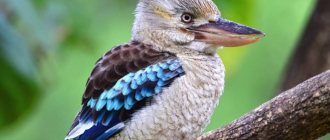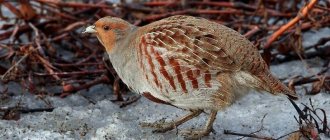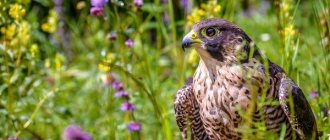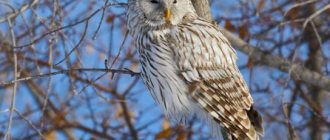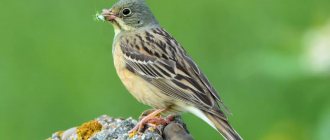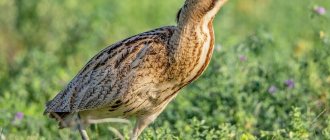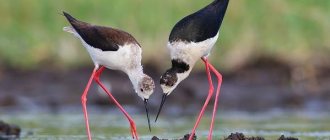The roller, for me personally, is a mystery bird - here in the westernmost point of Russia in the Kaliningrad region, this extremely rare species is listed in the Red Book. And I have never seen her in person. This is the “blue bird of happiness”.
Attitudes towards the roller vary greatly throughout its range. In particular, there is an opinion that in Ukraine at one time the roller was part of a group of birds that were considered untouchable. And in Central Asian countries, the roller is considered an “unclean” bird, and for this reason its nests are quite often destroyed.
Description and features
The common roller is a unique bird that belongs to the Roller family and the order Coraciiformes. It has striking iridescent plumage and looks very impressive in the sky. The flight style is very agile and fast, the wings flap strongly and sharply.
The individual's head, chest and wings on the inside have an unusual rich bluish tone with a turquoise-greenish transition.
The back is brown with rust, with a smooth transition at the beginning of the tail to blue-black with a bluish tint. The roller's wing is made of a combination of sky and green shades, with black transitions at the tips.
The roller bird is similar in size to a jackdaw or magpie. It has the following features:
- length up to 30-35 cm;
- weight can be 240 g;
- the constitution is good, proportional;
- wing spread up to 22 cm, wingspan about 65 cm;
- elongated sandy legs;
- on each foot three toes are turned forward and one is turned back;
- The adult has a large head on a short neck;
- darkened beak, hard and powerful, even in shape, with a hook-shaped upper part at the edge.
The bird has a peculiarity - at the base of the beak there are hard, bristle-like vibrissae (an organ of touch). This species moves along the surface of the ground with awkward hops, so it prefers to look for prey from tree branches.
The bird flies intermittently, gaining altitude and diving down. The flight often does not exceed more than 200-250 meters. The roller's voice is creaky and hard, reminiscent of the sound "more beautiful". Females and males are practically no different from each other.
Listen to the roller singing
Economic importance, protection.
Without a doubt, rollers are beneficial by destroying a huge number of different insects, including those harmful to agriculture. Recently, the number of rollers has been declining due to the cutting down of old-growth forests with hollow trees. This can be completely compensated for by artificial nesting sites, in particular in the 90s of the last century in Estonia, 7 pairs of rollers were attracted to nesting in this way. In some places, measures are being taken to preserve hollow trees in the nesting areas of this bird.
Roller from the brush of Durer.
Durer - roller wing.
Kinds
There are 8 species in the roller family, of which only the common species lives in the European and southern parts of Russia.
Each type has its own characteristics:
1. The lilac-breasted roller is distinguished mainly by its variegated color. The chest is lilac with a violet tint, the head and back of the head are green, and the eyes have a whitish stripe. Otherwise, the color is similar to a normal individual. The bird lives only in Africa. Her lifestyle is sedentary. Has two subspecies.
2. Abyssinian roller . The species is rare, lives in the center of Africa, has a spectacular color, diet - insects, small rodents.
3. Blue-bellied roller . The individual is distinguished by its dark green color on the back and cream on the head. Lives in Central Africa, feeds on termites. Individuals have pronounced territorial behavior - every bird that finds itself near the nest is attacked.
4. The Bengal roller has a brown chest color, not blue. It lives in the fields and meadows of South Asia, on the Arabian Peninsula to China, in India. It does not migrate, but in the off-season it makes flights over short distances. The bird became famous for the aerobatics of males during the mating season. Loves to swim and catch small fish. Has three subspecies. Several Indian states have chosen this bird as their symbol.
5. Sulawesi roller . This species is characterized by a rich blue color of the body and gray color on the head and tail. Indonesian rare species.
6. The Rufous-capped Roller is so named for its low, red-colored cap of feathers on its head. The chest also has a reddish-brown tone. The bird is sedentary, inhabits areas of sub-Saharan Africa, feeds on scorpions, spiders and lizards.
7. Racket-tailed roller . The individual lives in several countries in southeast Africa. It got its name from the long feathers along the edges of its tail. The color is similar to the common one, but has a white color on the head.
The family includes a rare subfamily that lives only in Madagascar - earthen rakshi. These birds run very quickly and quickly along the ground in search of food among the grass. They have very strong and long legs. They build nests in the ground in burrows.
General information about the squad
Raksha birds are tropical. These include todis, kingfishers, motmots, hoopoe, ground rakshi and rollers (or true rakshi). Kingfishers especially attract attention, plunging headlong into the water in search of fish, and also associated with classical mythology. The ancient Greeks believed that Ceyx and Alcyone (wife), who were shipwrecked on Delphi, turned into kingfishers. The Chinese used the sparkling blue feathers of some varieties of these birds to decorate paintings.
Other birds of this order - bee-eaters - are accused of hunting valuable bees. And in North America they are considered enemies due to the fact that bee-eaters prey on young fish in fish hatcheries. Another bird, the kookaburra, has a loud laugh and even a donkey’s voice. The roller is considered one of the most useful among its relatives.
The rest of the article provides more detailed information about this bird.
Lifestyle and habitat
Even decades ago, the common roller was found in large areas of Europe. But increased deforestation and the use of chemical fertilizers in the fields have deprived this species of the opportunity to live in its usual environment. In the northern regions of Europe, the species numbers, unfortunately, about one hundred thousand, at last count. In the southern regions of the range, on the contrary, the species population is large.
The roller is an ordinary migratory bird, and it returns to its nesting sites in April, and flies to hot countries for the winter in early September. Before the mating season, individuals live alone. The territories where the roller lives are quite extensive, mainly forest-steppe and steppe zones:
- In the south of Europe it settles in Spanish, French and German lands. Spain.
- Eastern Europe - completely.
- In some southern parts of Scandinavia.
- Southern Siberia.
- Central Asia.
- India, Pakistan.
- African countries and Australia.
In our country, birds can be observed in Moscow and the Moscow region, St. Petersburg, Kaliningrad, Kazan, in the east to the Altai Territory. There are settlements in the eastern part of the Urals. In the first half of the last century, in the north and west of the Ivanovo region, the bird regularly arrived in the summer. Now in these places, scientists admit the likelihood of nesting no more than a few pairs - unfortunately.
The roller loves to live in hollows, coastal hills and rocks, in pine forests, and parks. Gardens, willows and oaks also attract this bird. Birds love to settle in the steppe expanses; river coastlines, cliffs, and deserted places are perfect places for them to live. These birds can rise to a height of up to 3000 m above sea level in the mountains to create nests on steep cliffs.
In the northern territories, birds lead a migratory lifestyle and begin to gather for the winter in September. In hotter areas in the Caucasus and Crimean Peninsula, the roller remains until the beginning of October. Departure in small groups of individuals, one direction - to Africa. In tropical and equatorial countries, the bird leads a sedentary lifestyle.
Nutrition
Rollers feed mainly on live food, and they are omnivores. Birds watch their prey from above, nestling in the crown of a tree, a haystack, high-rise poles, and electrical wires. The diet often includes:
- large insects, in the spring - beetles, and from mid-summer - locusts;
- earthworms, wasps, flies;
- lizards are small;
- less often - small mice and frogs;
- berries, fruits and seeds - during the ripening period.
Seeing prey from above, the roller flies down with lightning speed and attacks it with its strong beak. When catching a small mouse, the bird rises high into the sky with it and throws it to the ground several times. And only then starts eating.
There is another option, which she uses: together with the prey, the individual climbs a tree. Holding the prey by the tail with its beak, it hits it with force with its head on a hard surface. The bird will do this until it is convinced that the prey is no longer alive. Only after this the prey will be eaten.
Reproduction
From year to year, the roller flies from the south to the same nesting areas, choosing hollows in trees or crevices in rocks for its future home. Roller nests are also built in a destroyed house, barn, as well as in old, dry wells. Hollows, adapted for nesting by birds, can be located at very different levels, both right near the ground and at a high altitude of up to 23-30 meters.
In coastal areas, in soft soil, the bird manages to dig a hole more than half a meter in length, the passage in the hole is 10-15 cm. At the end of it, a comfortable nesting chamber is built (30-50 cm), the height of the walls is up to 20 cm. The flooring inside can consist of a meager amount of dry herbs and foliage. It is also possible that there is no flooring.
In the spring, at the beginning of the mating season, the males rise to a decent height, uttering abrupt, sharp cries, then somersault down, also making sharp, strong sounds, inviting the female. These acrobatic dances with songs similar to the cry of “crawfish-crawfish” gave rise to another name for the roller – raksha.
Roller eggs are about three centimeters in volume; already in the first days of June, the female lays up to six eggs at once - they are glossy and white. Since eggs are laid within two days, hatching occurs from the first egg. Both individuals take part in this.
The pair actively protects the nest during the entire period of incubation and feeding of the chicks. Subsequently, the roller chicks , which hatched late, die from malnutrition. As a result, only the strongest survive in the amount of 2-3 individuals. Throughout the feeding of the bird, the hatching area is not cleaned.
The chicks hatch completely naked and blind. For 4-5 weeks, parents tirelessly feed their offspring and warm them with their warmth. After fledging, the young try to leave the nest, while remaining nearby.
And their parents continue to feed them. The color of young birds is not yet as bright as that of mature birds; they will acquire a bright turquoise color only after a year. At the end of the summer season, new offspring fly south.
Habitat.
The roller inhabits a fairly wide range of habitats, from forest and steppe to mountain and anthropogenic landscapes. The main requirement is the presence of old hollow trees and convenient perches (for example, wires) for hunting. In addition to hollows, it can dig itself or occupy other people’s holes in sandy or loess cliffs. Recently, the roller has become increasingly common in human settlements and its nests are found in the most unexpected places - power plants, poultry houses, in the cracks of houses. A nest is described in a ceramic jug walled into a wall in the Tashauz region of Turkmenistan.
Interesting Facts
The roller has some features that are very unusual and interesting:
- The bird has a certain property: in times of danger, the individual secretes a secretion from the stomach with a foul odor. This deters many predators. And the bird, thus, saves itself and preserves its nesting site with its chicks from attack.
- Birds, once created a pair, remain faithful to each other until the end of their lives.
- Over the past 30 years, the population of the species has declined sharply. In Europe, due to ecology and deforestation, and in southern countries (India) - the reason is shooting for delicacy meat. The bird is very often hunted for fun, stuffing, and for sale.
- Reckless deforestation and seasonal spring and autumn grass burning force birds to look for other territories for habitat and nesting.
- There are known facts of group living of pairs in one large hole, where each pair has its own spacious nest. In such a “communal apartment” the birds manage to avoid conflict and raise their chicks.
- The roller in the photo and video fascinates with its bright beauty and grace - it looks like a bird that has flown from paradise.
- Scientists have recorded the roller's ability to transfer chicks from one nest to another - this is very inconvenient and dangerous, and atypical for a bird.
- In the southern regions of our country, there are cases when older birds hatched eggs very “strongly,” especially old females. At this time, they can be easily caught in a hollow even with your hands.
- The roller eats large quantities of those insects that cause great harm to cultivated plants. For this, she is worthy of respect, since thereby she brings great benefits, saving crops and harvests from the scourge of pests.
- Unfortunately, the bird is in danger of extinction and is listed in the Red Book. Has the first category of rarity. In Moscow, Lipetsk, Kaluga, Ryazan and other regions, the species is under protection. The species' habitats and nesting sites are protected.
The common roller is a heavenly gift to our northern latitudes from distant and hot Asian and African countries. The very outfit of the birds screams about this. During migration, birds fly very long distances to return, have and raise chicks. Our task is to preserve this almost extinct species and create all the necessary conditions for its comfortable coexistence and increase in numbers.
Roller in the Red Book
The bird is on the verge of extinction, and therefore is listed in the Red Book. The bird is protected in a number of Russian regions - Kaluga, Ryazan, Lipetsk and many others. At the same time, they are protected as habitats. So are nesting areas.
The species is not only included in international standards, many countries where these creatures live also have their own protective structures for the safety of animals that are on the verge of extinction.
Main causes of extinction
The main threat to the decline in bird populations is hunting. This craft is often practiced in Mediterranean countries, as well as on the routes of bird emigration. Every spring season, thousands of birds are killed for their delicious meat.
In Europe, rollers are not hunted - here there is another equally worse threat. First of all, the loss of suitable areas for nesting. This happens due to various factors:
- changes in the natural landscape;
- a large number of pesticides;
- environmental pollution.
If we do not take any action, then in the future we will face the complete destruction of the entire population.
Birds are extremely sensitive to a reduction in the number of hedges.
Current population situation
In recent years, it has been noticed that the number of individuals in the entire population has been declining. There is no exact data regarding the number of individuals at a specific point in time. However, if we take into account the situation in the 80s, when there were already few birds, the current situation fully complies with the criterion of a rare species.
In particular, from the 70s to the 90s of the 20th century, there was a population decline of 30% over three generations. Because of this, the status in the international Red Book has changed - instead of LC it is now NT.
Do you need to take protective measures?
Various environmental measures are already being carried out in most European countries. An entire national plan has even been created to save the rare population of rollers.
The population of countries can also get involved in this process - it is enough to make nest boxes for birds.





